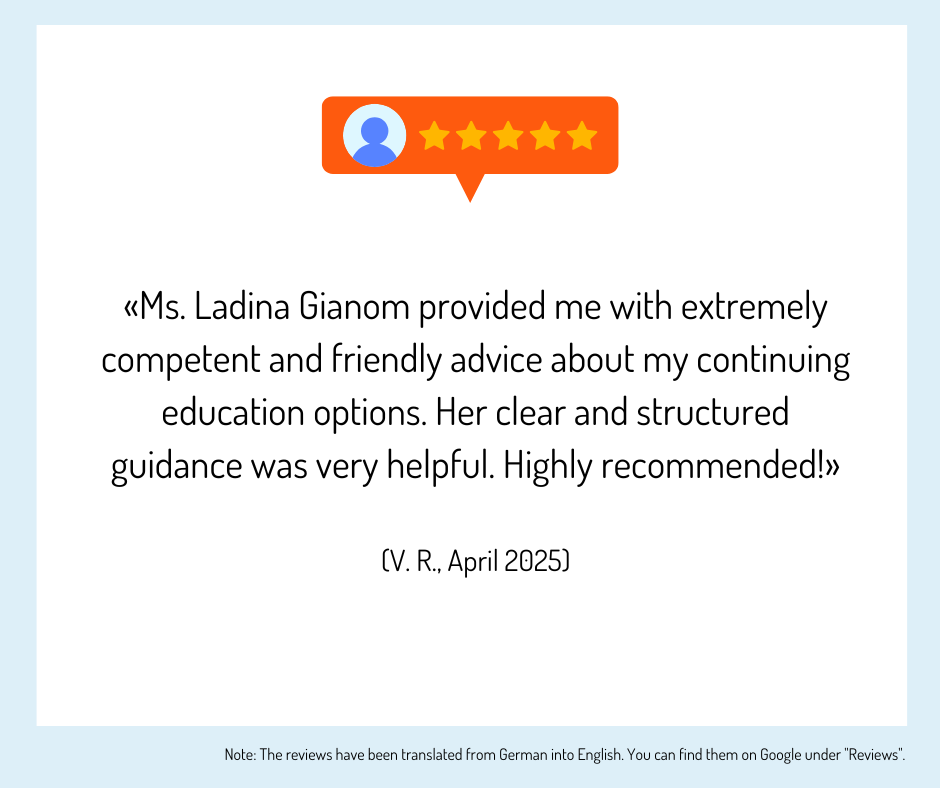Fashion (cert.) (Region Ostschweiz):
1 Provider
The following list shows you suitable providers:
Questions and answers
Training as a fashion designer - what opportunities are there?
The following options are available for training as a fashion designer:
- Fashion designer AFPE
- Designer CHE product design, specializing in fashion design
- Education at a Universities of Art and Design with a Bachelor's degree UAS in Fashion Design
- Bachelor UAS in Design, specialization Trends & Identity
- Education at a private school (with a corresponding non-federally recognized qualification)
What knowledge do you acquire in fashion consultant training?
The following knowledge is acquired in the fashion consultant training:
- Color theory
- Color analysis
- Style ladies
- Workshop
- 1x1 of styling ladies and gentlemen
- Make-up
- Textile science
- Hairstyles
- Accessories workshop
- Color and style consulting practice day
What jobs can I do after training as a fashion designer?
After training as a fashion designer, the following activities can be pursued:
- They design individual pieces, collections and accessories and present them at fashion shows.
- You are experienced in developing ideas and have knowledge of PR and planning.
- They combine creative talent with technical skill.
- They are competent in dealing with forms, colors and materials, deal with the zeitgeist, but also know the cultural-historical background and can place their work in this context.
Fashion continuing education, further training: Who is admitted to the Fashion Design CHE degree program?
Admission to the Fashion Design CHE degree program is open to those who
- have a Federal Diploma of Vocational Education and Training (VET Diploma) as a clothing designer
or
- have other previous textile training
and want to continue their design training or study fashion design.
The admission procedure includes a letter of motivation, a CV and work and training certificates. Anyone wishing to pursue CHE studies as continuing education, further training in the field of fashion must therefore carefully check in advance whether he or she can be admitted.
Further information can be obtained via the contact form of the respective school - quickly, easily and without obligation.
Why undergo styling training?
Styling training provides information about:
- Information about figure types for women and men
- Tips for flattering clothing
- Effect of light-dark contrasts, colors, structures, patterns, materials and volumes
- Visual effect of different cuts
- Knowledge of face shapes / necklines / collar shapes
Training as a fashion designer: What are the contents of the Product Designer CHE degree program with a focus on fashion design?
The contents of the Product Designer CHE degree program with a focus on fashion design are as follows:
- Ergonomics, shape, color, material
- Drawing
- CAD (Computer Aided Design) and visualization
- Visual communication and presentation
- Creating prototypes
- Legal basis
- Project management and business administration
- Trends and marketing
- Design history
- English or 2nd national language
- Projects and internship
This is therefore a very comprehensive fashion designer training program that lasts two to three years.
What skills do you acquire with a fashion designer apprenticeship?
Do you acquire the following skills with a fashion designer apprenticeship?
- Understanding and drawing the proportions of the figure, the fashionable movements of the body
- Understanding the basics of fashion design
- Sketching, drawing and coloring garments
- Display materials and patterns
- Customize fashion drawings
- Getting to know and using different coloring techniques
Why train as a fashion designer?
Fashion designers design products for all areas of the fashion and clothing industry. They design and create model collections. This includes the development of a design concept, the creation of model sketches, the selection of materials, colors and shaping details as well as the creation of a prototype, taking into account fit and production technology.
Apprenticeship as a clothing designer: what options are there?
There are various options for training as a clothing designer:
- Federal VET Diploma clothing designer
- Clothing designer FPE
- Clothing designer AFPE
Fashion design training - What are the possible requirements?
Possible prerequisites for training in fashion design could be
- You have a keen interest in fashion and enjoy your own creative process
- You would like to expand your tailoring and sewing skills
- Willingness to self-study
- German language skills at least level B2
As the requirements are set individually by each school, you should check them again to be sure.
What do you learn in a fashion design course?
In a fashion design course you learn the following:
- Deepening knowledge of pattern construction and processing technology
- Material science
- Own top/dress: from your own design to production
- Using the overlock sewing machine
- Processing stretchable materials
- Expanding and deepening sewing skills
- Work diary
What other topics can be covered in fashion stylist training?
Further topics of the Fashion Stylist training can be:
- Hairstyles for advertising, film, television and theater
- Using wigs correctly
- Insertion of hairpieces
- Twist in hair
- Blow dry
- Fantasy hairstyles with accessories
- Updos
- Period hairstyles (all hairstyles are made up according to type and accessorized with various accessories)
- Assigned tasks (e.g. forest spirit, star sign etc.)
- Sketching the work with the help of fashion drawings
- Preparation of hair (wigs, hairpieces, etc.) and headdresses
- Styling of scarves, ribbons etc.
- Color psychology
- Learning the manicure
- Attaching artificial fingernails
- Shading the hands
- Production of a hat/shoe finish
What do you learn in a fashion apprenticeship?
In a fashion apprenticeship you learn:
- Basics of tailoring, processing and cutting techniques
- Materials and costume studies: textiles and their properties, history and trends
- Design drawing: Means of design, methods of representation and realization of own ideas
- Color theory: sensitization, color qualities, symbolism
- Pattern realization: pattern derivation and realization of an own design (e.g. based on individual body measurements) in fabric, based on the basic cuts of a jumper or trousers.
Who is admitted to a Mode course?
Persons are admitted to a Mode course if they:
- have minimal sewing skills as a basis
- have your own sewing machine for self-study
- are prepared to invest additional time in self-study.
However, the admission requirements vary from school to school and should therefore be checked on a case-by-case basis.
Training for fashion designers: What do you learn in a Product Designer CHE degree program with a focus on fashion design?
In a Product Design CHE degree program with a focus on fashion design, you learn the following:
- Clarify and analyze order
- Analyze needs or market requirements on the basis of a specification sheet
- Negotiate conditions such as budget and deadlines with the client
- Clarify requirements and possibilities
- Designing and developing garments
- Turn initial ideas into sketches, drafts or mood boards
- produce, test and continuously improve several prototypes with different tools
- Organize regular meetings with customers
- manufacture the final product and create the production plans and computer graphics of the product on the computer
- Delivery and production of the garment
- Handover of the end product to the customer or project management
- Search for design publishers to clarify licensed productions or the sale of rights
- monitor the individual production steps and implement feedback for improvement
- Promote and sell fashion
- participate in marketing campaigns or organize and design showrooms
- present new clothing collections to the press or potential buyers
- develop digital communication strategies and present your own creations on various channels
Training for fashion designers covers the entire design process from creation to sales.
What are the requirements for training as a fashion designer?
The requirements for training as a fashion designer are:
- Creativity
- Sense of aesthetic and functional connections
- good imagination
- great interest in fashion, art, culture and history
Tips, tests and information on "Fashion (cert.)"
Experiences, evaluations and opinions on training / further education
Haven't found the right training or further education yet? Benefit from educational advice now!
Further training is not only important in order to maintain or increase professional attractiveness, investing in training or further training is still the most efficient way to increase the chances of a pay rise.
The Swiss education system offers a wide range of individual training and further education opportunities - depending on your personal level of education, professional experience and educational goals.
Choosing the right educational offer is not easy for many prospective students.
Which training and further education is the right one for my path?
Our education advisory team will guide you through the "education jungle", providing specific input and relevant background information to help you choose the right offer.
Your advantages:
You will receive
- Suggestions for suitable courses, seminars or training programs based on the information you provide in the questionnaire
- An overview of the different levels and types of education
- Information about the Swiss education system
We offer our educational counseling in the following languages on request: French, Italian, English
Register now and concretize your training plans.

Attraktive Services für Swisscom Mitarbeitende
Kostenlose Services
» Bildungsberatung (Wert: CHF 150.–)
Bildungs- und Businessratgeber (Wert: CHF 175.–)
» Rabatte
Attraktive Rabattierungen seitens der Bildungsanbieter.
» Massgeschneiderte Bildungsangebote
Ohne grossen Zeitaufwand den besten Trainer, Coach oder Schulungsanbieter finden
Bildungsangebot Schweiz
Aus über 700 Bildungsanbietern das richtige Bildungsangebot finden




